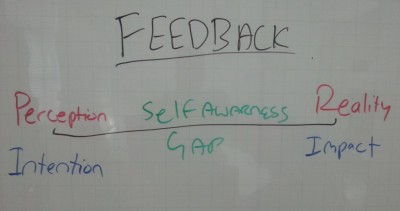
Feedback: It’s a Give and Take Thing
A lot of managers and even leaders don’t realise the importance of a strong and effective feedback system within their workplace and in the majority of cases it’s because they too don’t understand how to give and receive feedback themselves. Having a good feedback system will reduce confusion, promote a high performance environment and will improve employee morale.
Over time and through mistakes of my own I have come to the conclusion that feedback is the most essential ingredient to not only the advancement employee skills and learning but also to personal relationships and one of the main benefits of feedback is that it provides us with a method of self-awareness and creates a window of opportunity for us to improve ourselves.
What is Feedback?
Feedback is simply the process of being made aware of the reality of a situation. In other others it bridges the gap between our Perception and Intention and the Reality and Impact.

When looking at feedback there are two forms that you can provide, the first is positive feedback and the second is constructive. Positive feedback serves to promote or reinforce a certain behaviour while constructive feedback helps address any behaviours that you need to change or make adjustments to.
Positive Feedback
Now let’s look at a situational example of providing positive feedback.
Situation: I overhear Andrew our Business Development Manager speaking to potential customer and at the end of the call he gets the person involved with our new Blaze Cloud VPS. After the in our one on one say to him “Andrew I overheard you the other day and you did a great job closing a sales call.” and in my mind I think that’s reinforcing and being providing positive feedback to him. Well the truth is i’m not, why? I’ll show you below.
Let’s add a framework for providing feedback and then break down how I could improve the feedback I was providing. I’m going to use a system that was taught to me by my leadership coach John Colbert from Corporate Edge, (I also highly recommend him to anyone in the Sydney area) the framework is named P.E.E.R
1. Permission
Always get permission to provide feedback to the person you’re going to speak with.
2. Explain
Be very clear on what the behaviour was and why you’re reinforcing it.
3. Example
Provide specifics around when and where you witnessed the behaviour.
4. Result
Let the person know what the result of the behaviour was.
So knowing the PEER systems let’s now take a look at how I could have improved the feedback I was providing to Andrew.
“Andrew could I please give you some feedback on a call I heard the other day? (Yes) Thank you. I overheard a sales call you had with Matt Jones from KPMG on Tuesday, do you remember that call? (Yes I do) Awesome well I just wanted to say that questioning techniques you were using were great because they were open ended and you took the time to understand the customers needs before moving into the features and benefits of our Blaze Cloud VPS. That sale closed because you really addressed the customers needs and as a result today they have signed up another 4 servers with us. Please continue what you’re doing on your sales calls as it’s really making a difference and not just for Crucial but also our customers. At the end of the end of the talk I would also thank Andrew for the opportunity to provide feedback to him.
Which example do you think will provide immediate and long term benefits?
Constructive Feedback
It’s never easy either the person giving or receiving feedback and this is because it creates a form of pain human beings just aren’t wired to receive and accept pain so when this happens our brain tries to move us towards happiness or pleasure. Quite often people tend to avoid having the critical conversations needed to help an employee rather they may provide short remarks or just tell someone that they are doing something wrong. This approach or worse yet not saying anything at all hoping that the situation will go away will only hurt everyone and you will miss an opportunity for everyone to grow.
The next time an employee or even you require constructive feedback, think about it as an opportunity to create a positive impact on future behaviour. If delivered appropriately, constructive feedback can be the difference between success and failure.
Let’s take a look at a situation where constructive feedback has been delivered.
Situation: During a sales meeting you notice that one team member is cutting off other people when they are voicing their thoughts and proving input. As a result you also notice notice that after they get cut off they end up sitting there quietly during the rest of the meeting.
You might want to pull them aside and say: “Why were you cutting other people off during the meeting?” “You need to talk less and let other people have their turn?” Or, like many people tend to, you choose to ignore that it ever happened or go back to your desk and think about it for the rest of the afternoon. None of these responses are productive and they definitely won’t’ help you with managing the companies or your own expectations
Let’s apply P.E.E.R to this situation:
“Do you have a moment to chat, I’d like to provide you with some feedback regarding the meeting we had this morning (sure). During the sales meeting we had at 10am this morning I saw you cut off John and Mary when they were providing feedback on product X and as a result they didn’t get to offer their input and we all missed an opportunity to take on a few more viewpoints. Everyone’s input is valuable and as you’re aware one of our company values is that we’re team players so so in future meetings I would like to see you give everyone the opportunity to voice their thoughts before jumping back into the conversation.” Once again I would thank the person for letting me provide them with feedback.
Wouldn’t you agree that the outcome will be greatly different if you approached it this way?
Push back when giving Feedback
Now I briefly mentioned earlier about and the pain process that we go through when receiving feedback. I think this is very important to raise this as it will give you a much better understanding of why some people may react a certain way when receiving feedback. Even better you may see yourself staring in a mirror 🙂
1. Shock/Surprise – This is when we’re taken back and feel like weave been ambushed. “Where did this come from?”
2. Rejection – “That’s not me, I don’t do that, it’s because of you”.
3. Denial – This is when we try to talk ourselves out of the feedback. “ I’m not like that, I’m sure I don’t do that, no one else has said anything”
4. Reflection – Once our emotions have worn off we have the opportunity to think about the feedback. You may have thoughts such as “I wonder if anyone else has seen me do this or feels this way but haven’t spoken up?”
5. Acceptance – When we come to the realisation that the feedback is actually a reflection of our behaviours or actions and this is the golden moment when we have the opportunity to improve ourselves!
So How can we alleviate some of the pain when either giving or receiving feedback? Easy all we have to do is SEEK the feedback! The P.E.E.R framework works in the exact same way however replace the R (Result) with Respond. When seeking feedback always remember to;
- Trust that the intent is positive
- Listen to the feedback and being attentive to what you are being told
- Respond to the feedback then
- Clarify the feedback by feeding it back to the person providing it to you
- Execute your own action plan to improve the situation.
Feedback can be very rewarding when delivered and received properly, if you’re not getting enough of it in your workplace It’s a great opportunity to ask why and better yet use the framework above to get you started 🙂
| Hosting Options & Info | VPS | Web Solutions & Services |
|---|---|---|
